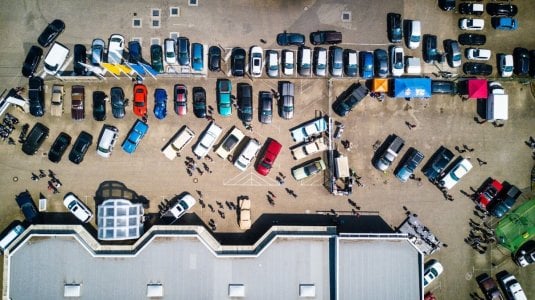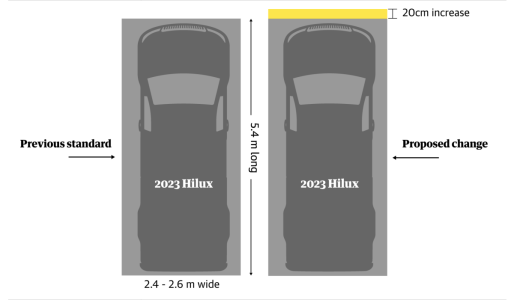Are parking spaces in Australia about to become bigger? Here's why this change is on the horizon
By
Seia Ibanez
- Replies 0
It's no secret that Australians love their utes and large cars; we're often seen as the nation of the family sedan and the 4WD ute.
We've seen a steady rise in the number of people buying larger vehicles over the past few decades. This is mainly attributable to a range of tax perks that have been implemented by the government, including the popular instant asset write-off scheme.
But as more Australians opt for bigger cars, planners have noticed a problem: parking spaces, both in on-street and off-street lots, are simply not large enough to accommodate every car owner.
The standard size for car spaces on streets and in parking lots has been 5.4 metres long and 2.4 to 2.6 metres wide – big enough to allow an old Ford Falcon or Holden Commodore to park comfortably.

However, the cars of today are markedly bigger than those of decades past. For instance, the top-selling vehicle in Australia in 2022 was the Toyota Hilux dual cab ute, which was about 5.27 metres long, a mere 70 centimetres or so less than a typical parking spot.
So, how is Australia meant to handle the increasing size of its cars? According to Standards Australia, the answer is simple: increase the size of the car spaces.
The authority has proposed extending the length of standard car spaces in off-street parking lots by an extra 20 cm. This, they believe, could represent 85% of Australia's vehicle fleet – and will provide breathing space for sports utility vehicles (SUVs), vans and large EVs, for which the weight issue must be taken into consideration.

However, this proposal has been met with mixed opinions.
Marion Terrill, the transport and cities director at the Grattan Institute, believes that creating longer parking spaces is ultimately normalising behaviour that should be discouraged.
'We’re already encouraging big vehicles and [making car spots longer] would just be another thing in that direction,' she said. 'There shouldn’t be an arms race to get even bigger vehicles.'
She then went on to detail the various hazards associated with larger vehicles: they can be harder to control and require more time to stop, they can make cyclists, pedestrians and drivers of smaller vehicles less safe, and they require more room on the roads.
On the other hand, Todd Mepham – an architect and urban designer – has argued that, while increasing car spaces to accommodate larger cars is not the most intelligent decision, it is somewhat necessary if Australians keep buying bigger vehicles.
He believes that all car parks need to be structurally assessed, and that ultimately we should stop building car parks altogether and start encouraging people to use public or active transport whenever possible.

So, with Australia's love affair with large cars showing no signs of slowing down, it looks like our parking spaces – and car parks – may soon become bigger than ever before.
Members, if you're out and about and notice car spaces at your local supermarket, shopping centre or petrol station – take a closer look, and don't be surprised if you see larger spots in the mix.
We've seen a steady rise in the number of people buying larger vehicles over the past few decades. This is mainly attributable to a range of tax perks that have been implemented by the government, including the popular instant asset write-off scheme.
But as more Australians opt for bigger cars, planners have noticed a problem: parking spaces, both in on-street and off-street lots, are simply not large enough to accommodate every car owner.
The standard size for car spaces on streets and in parking lots has been 5.4 metres long and 2.4 to 2.6 metres wide – big enough to allow an old Ford Falcon or Holden Commodore to park comfortably.

As Australians opt for bigger cars, parking spaces are not large enough to accommodate everyone. Credit: pexels
However, the cars of today are markedly bigger than those of decades past. For instance, the top-selling vehicle in Australia in 2022 was the Toyota Hilux dual cab ute, which was about 5.27 metres long, a mere 70 centimetres or so less than a typical parking spot.
So, how is Australia meant to handle the increasing size of its cars? According to Standards Australia, the answer is simple: increase the size of the car spaces.
The authority has proposed extending the length of standard car spaces in off-street parking lots by an extra 20 cm. This, they believe, could represent 85% of Australia's vehicle fleet – and will provide breathing space for sports utility vehicles (SUVs), vans and large EVs, for which the weight issue must be taken into consideration.

Standards Australia has proposed increasing the required length of off-street parking lots by an extra 20 cm. Source: The Guardian Australia
However, this proposal has been met with mixed opinions.
Marion Terrill, the transport and cities director at the Grattan Institute, believes that creating longer parking spaces is ultimately normalising behaviour that should be discouraged.
'We’re already encouraging big vehicles and [making car spots longer] would just be another thing in that direction,' she said. 'There shouldn’t be an arms race to get even bigger vehicles.'
She then went on to detail the various hazards associated with larger vehicles: they can be harder to control and require more time to stop, they can make cyclists, pedestrians and drivers of smaller vehicles less safe, and they require more room on the roads.
On the other hand, Todd Mepham – an architect and urban designer – has argued that, while increasing car spaces to accommodate larger cars is not the most intelligent decision, it is somewhat necessary if Australians keep buying bigger vehicles.
He believes that all car parks need to be structurally assessed, and that ultimately we should stop building car parks altogether and start encouraging people to use public or active transport whenever possible.
Key Takeaways
- Parking spaces in Australia may become larger in response to the growing popularity of SUVs and large cars.
- Standards Australia has proposed increasing the length of off-street parking lots by 20 cm.
- Critics argue that this change could encourage the purchase of larger vehicles and suggest more balanced solutions, such as making only some parking spots larger.
- There is growing concern about the safety impact of larger vehicles, with studies showing they contribute to higher road fatality rates.
So, with Australia's love affair with large cars showing no signs of slowing down, it looks like our parking spaces – and car parks – may soon become bigger than ever before.
Members, if you're out and about and notice car spaces at your local supermarket, shopping centre or petrol station – take a closer look, and don't be surprised if you see larger spots in the mix.







